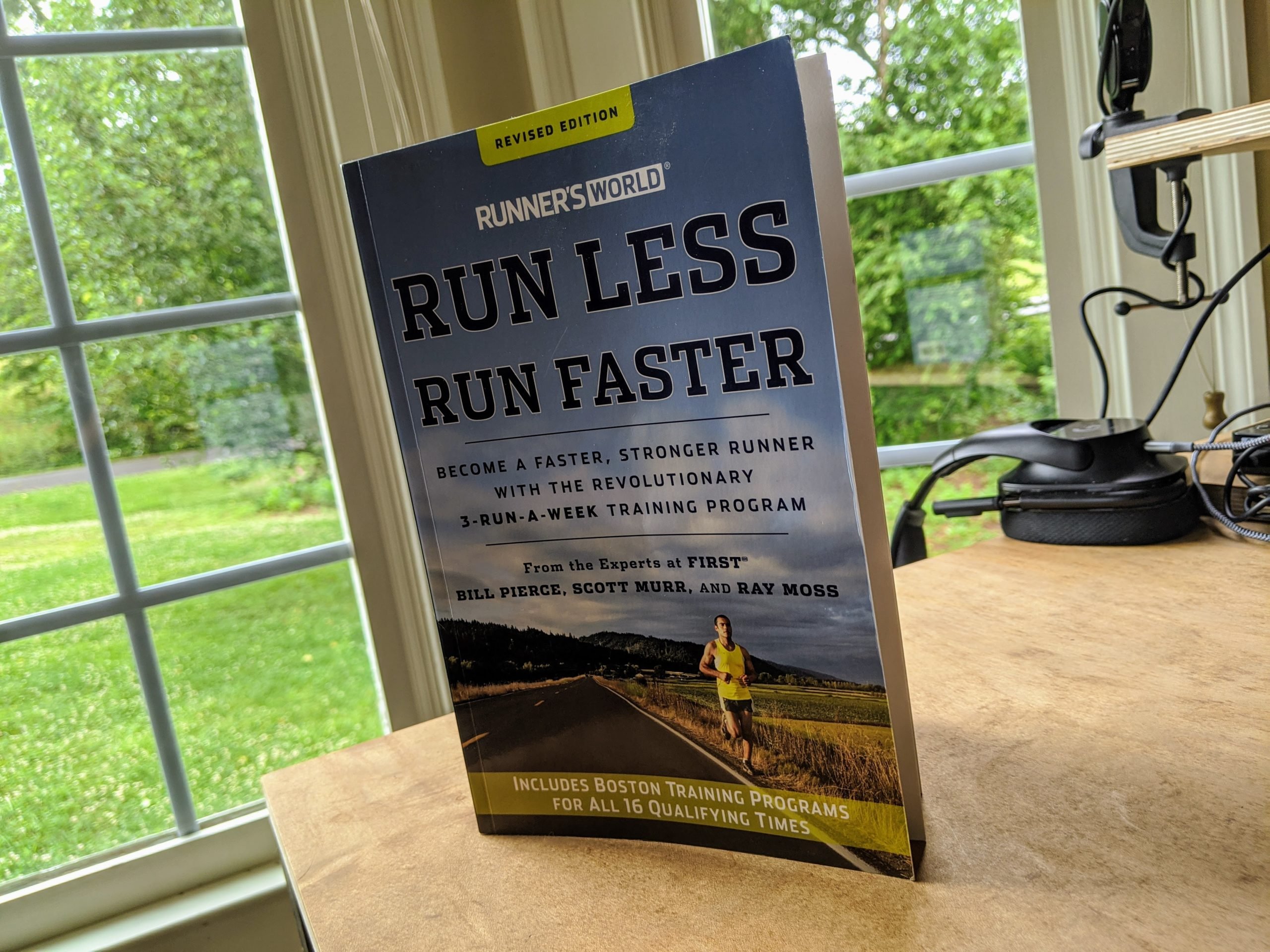Run Less Run Faster is a training manual for established runners who want to improve their race times while minimizing the risk of overuse injuries. The training program described in the book is built on real-world data and research drawn from the work of the Furman Institute of Running and Scientific Training (FIRST).
In essence, the book is a manual for improving your race time (5k to marathon distance) while only running three days each week.
Short Synopsis
Most running training plans suggest running five or six days per week, and on one or two of those days the prescribed run will be a long slow run. The central premise of the book is that running five or six days in a week, without sufficient rest days in between, dramatically increases your chance of experiencing an overuse injury. The solution the book proposes is to trim out those long, slow, recovery-type runs, which the authors of the book refer to as “junk miles”, and to replace them with non-weight-bearing cross-training.
The book proposes just three runs each week, all at fast tempos within striking distance of actual race tempos, with rest days in between. The program in the book suggests at least 2 days of cross-training using some sort of non-weight-bearing cardio exercise: cycling, rowing, or swimming. In addition, the book suggests regular weight training via a simple sequence of bodyweight exercises and a regular stretching routine.
In short, the book presents an entire training program for experienced runners who want to improve their race times while minimizing the risk of injury. The program includes three specific prescribed runs every week, two days of cardio cross-training, bodyweight exercises which should be completed at least three times per week, and a regular stretching routine.
In addition to presenting both the theory and practice of the training program, the book includes a number of quotes from runners who have used the program and seen gains in their race times while avoiding injury. The book also has a number of extensive tables which runners can use to determine the appropriate pace to run for the different runs prescribed by the program.
The book also has a chapter dedicated to new runners to try and help them ramp up to the amount of running prescribed in the program over a period of about 6 months (assuming they’re starting from zero).
What I Liked About the Book
The programs are detailed and complete.
While working out all the details certainly takes some effort, once you put in that effort you have a detailed training plan ranging from 12 to 16 weeks which you can use to target whatever race distance you’re running next (5k, 10k, half-marathon, or marathon) and even to create a plan of attack for qualifying for the Boston Marathon.
While the book is for established runners, it provides some guidance to beginner and intermediate runners.
The book is definitely for established runners. Week one of the 5k training program has you running 10+ miles once you add in the warmup / cooldown jogs before and after each actual run. That is way too much for a brand new runner. The book compensates for this by including one chapter for new and intermediate runners that includes a bare-bones program for getting up to speed.
The running plans are incredibly detailed.
Each program consists of three different types of runs. The different types are each described in detail and pace guidance is highly specific. The program doesn’t leave any question about what you’re supposed to do. You know exactly what you’re supposed to do.
The program is fairly flexible.
The program allows space for illness, minor injury, and provides advice for completing the program even if you don’t have access to things like an actual running track.
What I Disliked About the Book
The program is complex. Perhaps that’s necessary, but I found it fairly daunting. If you aren’t used to measuring distance and pace precisely, you’re going to feel like you’re in over your head. If you’re someone who just likes to step out your door and enjoy a nice run, this program is not for you.
In addition, and perhaps this isn’t fair, but to some degree the book just wasn’t what I was expecting. In two different ways, I felt like the book was a bit of a bait-and-switch.
First, the cover of the book can give you the impression that all you have to do to become a faster and stronger runner is to run three times per week. Well, yes, but in addition you have to crosstrain twice per week, do a bodyweight exercise program several times a week, and spend 20-30 minutes every day stretching.
A program that seemed to demand just 2-3 hours per week, based on the title, will actually demand a solid 8-10 hours per week to do it all.
Second, the book is at least half charts and quotes from folks who use the program. I’d have loved to have seen the section for new runners expanded to two or three chapters and the amount of space dedicated to publishing the praise received from runners reduced.
Who Should Get the Book
This book is a great resource to folks who are serious about running faster.
It will be particularly valuable to experienced runners who want to improve their race performance without running more than three days per week to minimize the chance of injury. In addition, I’m struck that the program seems a particularly strong fit for triathletes whose swimming and cycling workouts will be a natural fit for the cross-training included in the program.
If you buy this book, go in with your eyes open. A lot of the book is tables of data and letters written by runners to the authors. If you buy the book, you’re buying it for the information and for the program, not because it makes for riveting reading.
